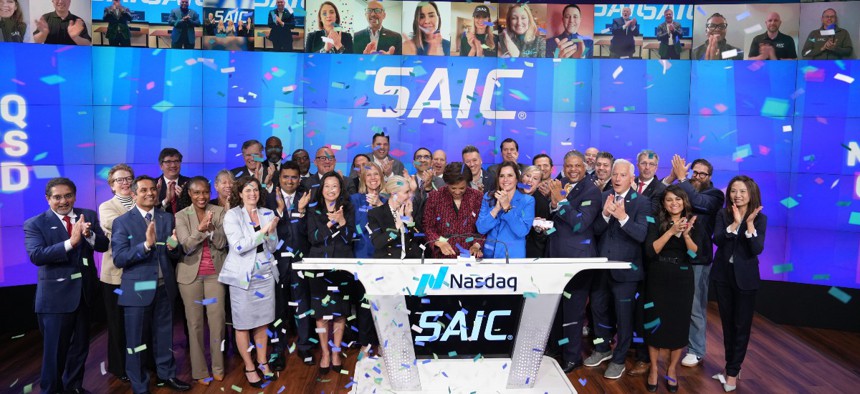SAIC details its blueprint to reinvigorate growth and innovation

SAIC's executive team rings the closing bell on April 11 at the NASDAQ Marketsite in New York City. Courtesy of Business Wire.
Science Applications International Corp.'s CEO and chief innovation officer started their new jobs on the same day and spoke with investors together to detail where the company wants to go.
The temptation is high to fixate on the symbols that surround a company's messaging about itself, which can be distracting from the substance of what that company is trying to tell us.
Yet it is worth noting that Science Applications International Corp.'s stock started to trade on the tech-heavy NASDAQ market on March 5. SAIC shares had been listed since its 2006 initial public offering on the New York Stock Exchange, where a vast majority of publicly-traded GovCon stocks trade.
The change in listing may be superficial but also coincides with SAIC's launch of its new multi-year vision and strategy for growth, which the company revealed during its April 11 Investor Day event (which you should watch too) at the NASDAQ Marketsite in New York City.
Toni Townes-Whitley has provided investors, and by extension employees and customers, glimpses at that new blueprint during her now-six months as SAIC's chief executive.
Investments in its technology capabilities, business development engine and talent upskilling initiatives are among the "three flavors" of them as she described in a March earnings call.
But CEOs almost always have a story to tell for any three-hour investor day event and Townes-Whitley followed that tradition, in part with this statement on where SAIC has been and where it wants to go for itself and federal agency clients:
"(At) last year's investor day, we said we aspire to be a trusted integrator, and that aspiration remains. But what we've learned and acknowledged, and it's shown up in the data on some of our recompete losses, is that to be a trusted integrator and a long-term partner to your customer, we've got to introduce more value and innovation through the lifetime of the contract. We've got to also bid more into the market and we've got to differentiate our portfolio more significantly."
The tech aspect is where Lauren Knausenberger, formerly the Air Force's chief information officer for seven years, enters the equation as SAIC's chief innovation officer to spearhead that effort. She started the job on Oct. 2, the same day that Townes-Whitley began her CEO tenure.
During Knausenberger's presentation for investors, she acknowledged that SAIC had "lost a few bids in the past" purely on the technical scores. She obviously does not want that to happen anymore and part of her mandate is to make sure of it.
SAIC's innovation factory will play a key role in that effort as those folks "are the ones delivering the digital and the engineering capabilities that we bring to market," Knausenberger said.
A team of other delivery specialists at the company are sold "by the sprint" to solve customer problems and represent the integration of services with SAIC's digital and engineering solutions, Knausenberger added.
One key cog of how SAIC will look to lead in technology is its emphasis on secure multi-cloud solutions, which requires the company to go to market with all of the major hyperscale providers.
To its credit, SAIC has strung together several large wins on that front over the past few years to become in essence an agency's lead enterprise cloud broker. See the $1.3 billion Treasury T-Cloud booking as one example, plus the $728.2 million Air Force Cloud One program.
"They are the vast majority of the compute within the duty as well as the vast majority of the enterprise services, and they do really hard things," Knausenberger said. "Part of this is deploying business applications. Part of this is doing command and control at multiple levels of classification, not just unclassified, secret, top secret. Some of the policy challenges that happen with that are very complex."
Investor day events also prominently feature a company's new financial outlook and goals. SAIC's fiscal 2024 numbers are the starting point for where it wants to go: $7.4 billion in revenue on $680 million in adjusted EBITDA (earnings before interest, taxes, depreciation and amortization).
By 2027, the company is targeting $7.95 billion-to-$8.1 billion in sales on $750 million-to-$780 million in adjusted EBITDA. That translates to goals of a 3.5% compound annual growth rate on the top line and 4.5% CAGR on the bottom line. SAIC runs its fiscal calendar on a February-January basis.
SAIC's work to either make or break past those numbers via recompetes, new business wins and on-contract growth will be all about process and introducing innovation. Not necessarily innovation at the speed of need, but when agencies are ready for it.
Townes-Whitley acknowledged that "introducing innovation to customers in our market is super difficult" for contractual and policy reasons, which means that other customers have to be identified out of that initial group.
"It's a real consultative skill set to say 'Hey, you didn't mention this need, but I see you have it. You don't see that the convergence is happening in the market. Let me introduce you, let me bring that,'" Townes-Whitley said.
"How we shift to being able to say what we know and the tech that we have learned, how we compose that for our customer, is a skill set, and it is a cultural shift for us to move in that direction and feel comfortable leaning in with that kind of consultative sale."
Below is Townes-Whitley speaking to CNBC's "Squawk Box" program on April 11 prior to the Investor Day.
And here is SAIC's executive team ringing the closing bell at the NASDAQ Marketsite in New York City, also on April 11.


